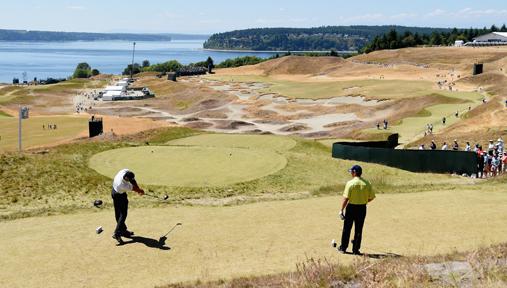
It really is ridiculous how most of the leading professional golfers in the world think they have a right to have course conditions that suit them perfectly.
– VIDEO: Tiger Woods’ desire questioned at Chambers Bay
– VIDEO: Mcllroy – Ryder Cup reason for Europeans’ major success
– Chris Wood seals Lyoness Open title after five-shot comeback
Just because it is different from what they get week-in and week-out, Chambers Bay golf course, host venue of this week’s 115th US Open championship, has been severely criticised by some.
Most others have tried to remain diplomatic, while the only glorious review for the course seems to have come from Phil Mickelson.
The United States Golf Association (USGA) always takes great pride in setting up courses that offers the sternest test to the players.
Invariably, the winning score is close to par and performances like Tiger Woods in 2000 at Pebble Beach, Rory McIlroy at Congressional in 2011 and Martin Kaymer’s at Pinehurst last year are examples of supreme efforts by talented golfers in great form.
All the prep is done. This is going to be an epic test. Chambers Bay is different than anywhere else. Let’s go @usopengolf!! #pars
— Blayne Barber™ (@BlayneBarberAU) June 18, 2015
After the USGA selects a golf course, they then work on it for years to doctor it to suit their own doctrine of course set-up.
This typically includes a combination of graded and thick rough, lightning fast and rock hard greens, narrow and firm fairways, and some incredibly lengthy holes.
This year, they chose Chambers Bay. It is only the third time that the USGA have gone for a public golf course, and the first time they have picked a links course.
There are several unique features of the golf course – like the variable pars on the first and 18th holes, an elevated and a depressed tee on a par-3 hole, the presence of a 10-feet deep bunker in the middle of the fairway and a functional railway track as part of the course.
But these are not going to give the pros any sleepless nights. What they have major issues with are the many mounds on the golf course that give an unpredictable bounce to the ball, and that some of the greens have so many gradients it is virtually impossible to find four good pin positions during the tournament.
The view from the (forward) tee at Chambers Bay’s finishing hole. #USOpen pic.twitter.com/MdkvZ2uIjE
— PGA TOUR (@PGATOUR) June 18, 2015
They also don’t like the greens because they do not have the perfect roll.
The USGA’s Mike Davis set the cat among the pigeons by announcing that he is planning to have sloping lies on the tees.
All the problems that players are facing at Chambers Bay, are what you get on most links courses.
A favourable, or a bad bounce, is as much part and parcel of links golf as greens with severe contours and uneven lies.
The players should count themselves lucky that they will at least get warm and consistent temperatures in Seattle, which is a rare commodity in the whole of UK, which has some of the finest links courses in the world.
And then there is the number one reason to stop moaning and get on with the game – conditions are the same for each and every player in the 156-man field.
Will be a very interesting 115th United States Open…not sure how these greens will hold up #ChambersBay #USOpen pic.twitter.com/IRqHltYkkX
— Ryan Burr (@RyanBurr) June 18, 2015
Unless someone like the 15-year-old Cole Hammer, or the 51-year-old Colin Montgomerie wins the tournament, you can rest assured that the guy who has played the best golf over four days will win the tournament.
In fact, I welcome the unpredictability of Chambers Bay because with the parkland style courses, the US Open was becoming quite predictable.
It was a grind and almost one-dimensional with the majority of players having similar gameplans.
Now, at Chambers Bay, there is a chance that they will use creativity and some thought in hitting their shots. I am not sure about the players, but it really promises to be four great days of golf for the spectators.